Module resync
This document contains technical documentation for the resync module.
To browse the source code, visit the repository on GitHub.
This module contains a large set of VHDL entities for clock domain crossing (CDC) of data in an FPGA. Everything in this module is properly and carefully constrained, and has a thought-out structure to ensure stable operation.
Note that most of the entities in this module have scoped constraint files that must be used for proper operation. This also means that certain build tool settings need to be considered for the constraints to work. Please see this article this article for details.
See asynchronous_fifo.vhd if you want to use asynchronous FIFO as a CDC solution. For AXI buses, there is also axi_address_fifo.vhd, axi_r_fifo.vhd, axi_w_fifo.vhd, axi_b_fifo.vhd, axi_read_cdc.vhd, axi_write_cdc.vhd.
resync_counter.vhd
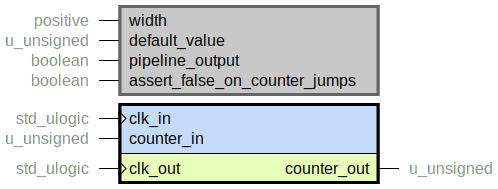
Synchronize a counter value between two domains using Gray-coded values.
Converts the binary input counter word to Gray code, resynchronizes it to the
output clock domain with an async_reg chain, and converts it back to a binary number.

Note that unlike e.g. resync_level.vhd, it is safe to drive the input of this entity with LUTs as well as FFs.
Note
This entity has a scoped constraint file resync_counter.tcl that must be used for proper operation. See here for instructions.
Warning
This entity assumes that the input counter value only increments and decrements in steps of one. Erroneous values can appear on the output if this is not followed.
See the constraint file and this article for information about timing constraints and how this CDC topology is made reliable.
Resource utilization
This entity has netlist builds set up with automatic size checkers in module_resync.py. The following table lists the resource utilization for the entity, depending on generic configuration.
Generics |
Total LUTs |
LUTRAMs |
FFs |
Maximum logic level |
|---|---|---|---|---|
width = 8 |
11 |
0 |
24 |
3 |
width = 16 |
23 |
0 |
48 |
4 |
width = 24 |
35 |
0 |
72 |
6 |
width = 32 |
59 |
0 |
96 |
3 |
width = 64 |
123 |
0 |
192 |
4 |
resync_cycles.vhd
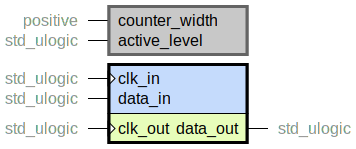
Resynchronizes a bit, so that the output bit is asserted as many clock cycles as the input bit.
Note
This entity instantiates resync_counter.vhd which has a scoped constraint file that must be used.
This module counts each clk_in cycle the input bit is asserted.
The counter is resynchronized to clk_out, and used as a reference to know
how many clk_out cycles the output bit should be asserted.
Note that unlike e.g. resync_level.vhd, it is safe to drive the input of this entity with LUTs as well as FFs.
Counter width
The module may fail when clk_out is slower than clk_in and the input is
asserted many cycles in a row.
An RTL assertion is made to check for this error in simulation.
Increasing counter_width increases the tolerance for this error.
Resource utilization
This entity has netlist builds set up with automatic size checkers in module_resync.py. The following table lists the resource utilization for the entity, depending on generic configuration.
Generics |
Total LUTs |
LUTRAMs |
FFs |
Maximum logic level |
|---|---|---|---|---|
counter_width = 8 |
26 |
0 |
41 |
5 |
counter_width = 16 |
31 |
0 |
81 |
7 |
counter_width = 24 |
45 |
0 |
121 |
9 |
counter_width = 32 |
69 |
0 |
161 |
9 |
counter_width = 64 |
140 |
0 |
321 |
17 |
resync_level.vhd
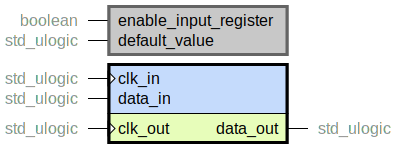
Resync a single bit from one clock domain to another, using two async_reg registers.

The two registers will be placed in the same slice, in order to maximize metastability recovery, which minimizes mean time between failure (MTBF). This enables proper resynchronization of semi-static “level”-type signals without meta stability on rising/falling edges.
Note
This entity has a scoped constraint file resync_level.tcl that must be used for proper operation. See here for instructions.
Warning
This entity works only for semi-static “level”-type input signals. This entity can not handle “pulse”-type signals. Pulses can be missed and single-cycle pulse behavior will not work.
See the constraint file and this article for information about timing constraints and how this CDC topology is made reliable.
Deterministic latency
If you want a deterministic latency through this resync block, via a set_max_delay
constraint, the enable_input_register generic must be enabled and the clk_in
port assigned.
If it is not, a simple set_false_path constraint will
be used and the latency can be arbitrary, depending on the placer/router.
Glitches
The enable_input_register generic helps to prevent sampling of data when the input is in a
transient “glitch” state, which can occur if it is driven by a LUT as opposed to a flip-flop.
When this option is enabled, the clk_in port must be driven with the correct clock.
Note that this is a separate issue from meta-stability; they can happen independently of
each other.
If the input is already driven by a flip-flop, you can set the generic to false in
order to save resources.
But notice though, as stated above, that this will result in a set_false_path constraint
being used, which can result in quite arbitrary latency.
resync_level_on_signal.vhd

Sample a bit from one clock domain to another.
Note
This entity has a scoped constraint file resync_level_on_signal.tcl that must be used for proper operation. See here for instructions.
This entity does not utilize any meta stability protection.
It is up to the user to ensure that data_in is stable when sample_value is asserted.
Note that unlike e.g. resync_level.vhd, it is safe to drive the input of this entity with a LUT as well as an FF.
resync_pulse.vhd

A robust way of resyncing a pulse signal from one clock domain to another.

Note
This entity has a scoped constraint file resync_pulse.tcl that must be used for proper operation. See here for instructions.
Note that unlike e.g. resync_level.vhd, it is safe to drive the input of this entity with a LUT as well as an FF.
See the constraint file and this article for detailed information about timing constraints and how this CDC topology can be used reliably.
Pulse overload
The barebone pulse CDC is vulnerable to pulse overload, meaning that if multiple pulses arrive close together, some or all of them can be missed. This can happen if the distance between input pulses is not significantly greater than two output clock domain cycles.
To re-formulate this problem, the design is safe and can not miss pulses if
The output clock is significantly more than two times faster than the input clock, or
The user knows from the application that input pulses can not happen often.
Otherwise it is unsafe, and pulses can be missed. Using the feedback level mechanism, as described below, can mitigate this problem.
Feedback level
This entity features an optional feedback level and input gating which mitigates the pulse overload problem. When this is enabled and the pulse overload scenario happens, the feedback will guarantee that at least one pulse arrives on the output.
Note that pulses can still be missed, meaning fewer pulses might arrive on the output than were received on the input. But, once again, the mechanism guarantees that at least one pulse arrives.
Hence, this CDC in this configuration is not suitable for applications where the exact pulse count is important. It is more suitable for situations where the user wants to know wether or not something has occurred, and not the exact number of times it occurred.
The feedback level and input gating mechanisms are enabled by the
enable_feedback generic.
Note that it has default value true, since that is considered the most robust behavior.
Resource utilization
This entity has netlist builds set up with automatic size checkers in module_resync.py. The following table lists the resource utilization for the entity, depending on generic configuration.
Generics |
Total LUTs |
FFs |
|---|---|---|
enable_feedback = False |
2 |
4 |
enable_feedback = True |
3 |
7 |
resync_rarely_valid.vhd
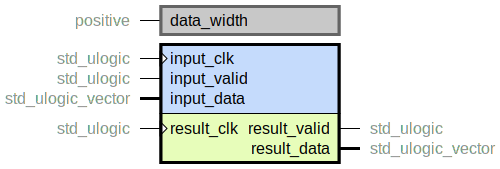
Simple CDC where a data word, qualified with a valid signal, is resynchronized from
one clock domain to another.
The input_valid must be pulsed for one clock cycle when the input_data is valid,
which will result in one result_valid pulse once data has propagated.
This CDC features no feedback and no backpressure, and will fail if input words arrive
too close together.
It is up to the user to make sure that this does not happen.
There needs to be at least 1 input clock cycle and 3 result clock cycles between
between each word.
Warning
This CDC topology is inherently unsafe and should be used with a lot of caution.
If input words arrive too close together, there will be corrupted and/or metastable
result words.
There is no monitoring/detection/reporting mechanism for such events.
Use this entity only if
you are absolutely sure, due to the design of upstream logic, that
inputwords will never arrive “too close”, oryou have some status feedback mechanism outside of this entity.
The name of this CDC topology comes from the fact that valid may only arrive quite rarely.
And also, due to its inherent unsafe nature, it is rarely a valid choice to use this CDC.
This CDC features no ready signals for backpressure.
See e.g. resync_twophase_handshake.vhd or asynchronous_fifo.vhd
instead if backpressure is needed, or if the flow of data is unknown.
Warning
This entity is in active development. Using it is NOT recommended at this point.
Note
This entity has a scoped constraint file resync_rarely_valid.tcl that must be used for proper operation. See here for instructions.
Note
TODO:
Add constraints.
Run post synthesis simulation.
Test on hardware.
Resource utilization
This entity has netlist builds set up with automatic size checkers in module_resync.py. The following table lists the resource utilization for the entity, depending on generic configuration.
Generics |
Total LUTs |
LUTRAMs |
FFs |
Maximum logic level |
|---|---|---|---|---|
data_width = 8 |
2 |
0 |
21 |
2 |
data_width = 16 |
2 |
0 |
37 |
2 |
data_width = 24 |
2 |
0 |
53 |
2 |
data_width = 32 |
2 |
0 |
69 |
2 |
data_width = 64 |
2 |
0 |
133 |
2 |
resync_rarely_valid_lutram.vhd

Simple CDC where a data word, qualified with a valid signal, is resynchronized from
one clock domain to another.
The input_valid must be pulsed for one clock cycle when the input_data is valid,
which will result in one result_valid pulse once data has propagated.
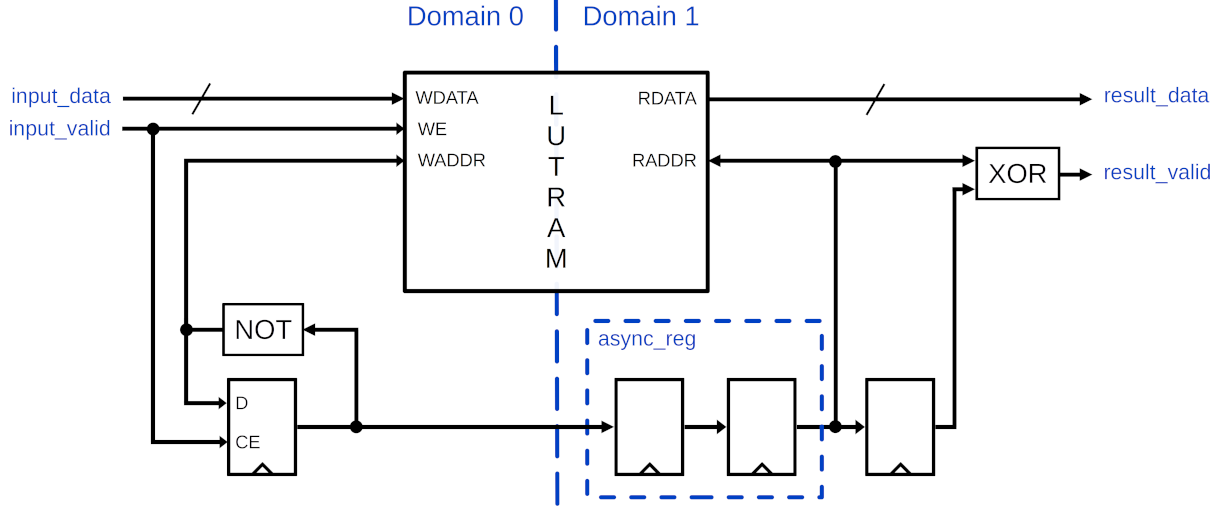
Very similar to resync_rarely_valid.vhd but uses LUTRAM instead of registers, making it extremely resource efficient.
See resync_rarely_valid.vhd for further information and some usage instructions.
Warning
This entity is in active development. Using it is NOT recommended at this point.
Note
This entity has a scoped constraint file resync_rarely_valid_lutram.tcl that must be used for proper operation. See here for instructions.
Note
TODO:
Add constraints.
Investigate synthesis bug. Outputs are driven to ground through LUTs.
Run post synthesis simulation.
Test on hardware.
Resource utilization
This entity has netlist builds set up with automatic size checkers in module_resync.py. The following table lists the resource utilization for the entity, depending on generic configuration.
Generics |
Total LUTs |
LUTRAMs |
FFs |
Maximum logic level |
|---|---|---|---|---|
data_width = 8 |
10 |
8 |
4 |
2 |
data_width = 16 |
14 |
12 |
4 |
2 |
data_width = 24 |
18 |
16 |
4 |
2 |
data_width = 32 |
26 |
24 |
4 |
2 |
data_width = 64 |
46 |
44 |
4 |
2 |
resync_slv_level.vhd
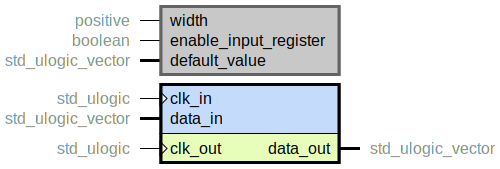
Resync a vector from one clock domain to another.
Note
This entity instantiates resync_level.vhd which has a scoped constraint file that must be used.
This simple vector resync mechanism does not guarantee any coherency between the bits. There might be a large skew between different bits. It will also not be able to handle pulses in the input data, but can instead only handle semi-static “level”-type signals.
It does however have meta-stability protection.
See resync_level.vhd for details about constraining and usage of
the enable_input_register generic.
resync_slv_level_on_signal.vhd

Sample a vector from one clock domain to another.
Note
This entity instantiates resync_level_on_signal.vhd which has a scoped constraint file that must be used.
This modules does not utilize any meta stability protection.
It is up to the user to ensure that data_in is stable when sample_value is asserted.
It will not be able to handle pulses in the data and does not feature any bit coherency.
Hence it can only be used with semi-static “level”-type signals.
Note that unlike e.g. resync_level.vhd, it is safe to drive the input of this entity with LUTs as well as FFs.
resync_sticky_level.vhd

Resync a sticky status bit from one clock domain to another.
If input_event is high at any point, the result_sticky will be raised and will
remain high.
There is no way to reset this value.
Typical use case is to CDC a critical error bit, which might exhibit a pulse-like behavior,
from one clock domain to another.
This entity is a very small wrapper around resync_level.vhd.
Latency
By default, the enable_input_register generic which is propagated to
resync_level.vhd is false.
This will result in a set_false_path constraint for the level signal that crosses
clock domains.
This will yield an arbitrary build-dependent latency.
If a deterministic and bounded latency is required, set the enable_input_register to true
to get a set_max_delay constraint.
resync_twophase.vhd

Free-running two-phase CDC for resynchronizing a vector of correlated data from one clock domain to another. Unlike e.g. resync_slv_level.vhd, this entity contains a mechanism that guarantees bit coherency.
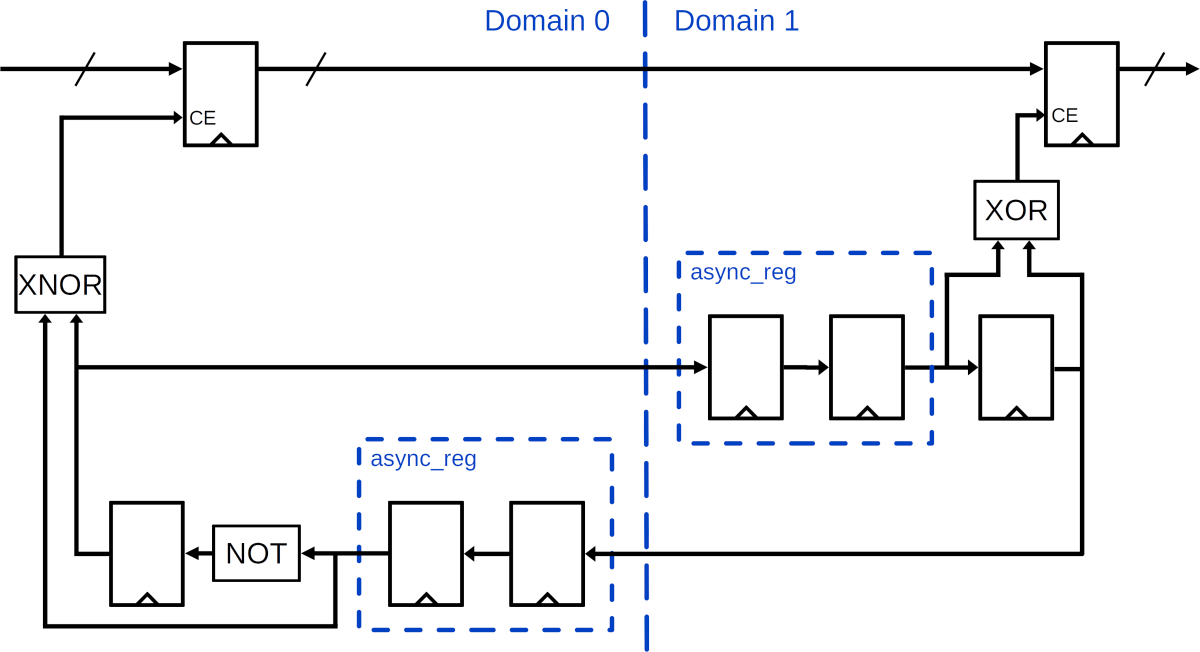
A level signal is rotated around between input and output side, with three registers in each direction. The level toggles for each roundtrip, and data is sampled on each side upon a level transition. This ensures that data is sampled on the output side only when we know that the sampled input data is stable. Conversely, input data is only sampled when we know that data has been sampled on the output in a stable fashion.
Note
This entity is free-running, meaning that it will sample and resync input data back-to-back. See resync_twophase_handshake.vhd for a version that features AXI-Stream-like handshaking on the input and result sides.
This entity is suitable for resynchronizing e.g. a control/status register or a counter value, which are scenarios where bit coherency is crucial. It will not be able to handle pulses in the input data, it is very likely that pulses will be missed.
Note
This entity has a scoped constraint file resync_twophase.tcl that must be used for proper operation. See here for instructions.
Note that unlike e.g. resync_level.vhd, it is safe to drive the input of this entity with LUTs as well as FFs.
Latency and resource utilization
The latency from input to output, given the constraints that we apply, is in the absolute worst case almost equal to
4 * period(clk_in) + 4 * period(clk_out)
Depending on
which state the level signal is in,
the place/route result,
and how the clock edges align,
the latency from input to output can be significantly lower. This is also how the sampling period of the signal behaves. As such this resync is not suitable for signals that change quickly. It is instead typically used for e.g. slow moving counters and status words, or other data where the different bits are correlated.
The LUT utilization is always 3. The FF utilization increases linearly at a rate
of 2 * width.
Compared to resync_counter.vhd this entity has lower LUT and FF usage in all scenarios. It does however have higher latency.
Another way of achieving the same functionality is to use a shallow asynchronous_fifo.vhd
with write_valid and read_ready statically set to 1.
The FIFO will however have higher LUT usage.
FF usage is higher for the FIFO, up to around width 32 where this entity will consume more FF.
Latency is about the same for both.
Why is this a separate implementation?
In terms of functionality, this entity is identical to resync_twophase_handshake.vhd,
but with handshaking input_valid and result_ready tied to '1'.
However, doing it like that results in a slightly higher result utilization
than a purpose-specific implementation as in this file.
Resource utilization
This entity has netlist builds set up with automatic size checkers in module_resync.py. The following table lists the resource utilization for the entity, depending on generic configuration.
Generics |
Total LUTs |
LUTRAMs |
FFs |
Maximum logic level |
|---|---|---|---|---|
width = 8 |
3 |
0 |
22 |
2 |
width = 16 |
3 |
0 |
38 |
2 |
width = 24 |
3 |
0 |
54 |
2 |
width = 32 |
3 |
0 |
70 |
2 |
width = 64 |
3 |
0 |
134 |
2 |
resync_twophase_handshake.vhd

Two-phase handshaking CDC for resynchronizing a vector of correlated data from one clock
domain to another.
Features an AXI-Stream-like handshaking interface on both the input and result side.

In many ways this entity is a superset of resync_twophase.vhd, so see that
for some more insight.
But this one features ready/valid handshaking, which enables backpressure but increases
Resource utilization slightly.
Note
This entity has a scoped constraint file resync_twophase_handshake.tcl that must be used for proper operation. See here for instructions.
Note that unlike e.g. resync_level.vhd, it is safe to drive the input of this entity with LUTs as well as FFs.
Latency
The latency from input to result is less than or equal to
period(input_clk) + 3 * period(result_clk),
Throughput
The sampling period (inverse of throughput) of is roughly equal to
3 * period(input_clk) + 3 * period(result_clk).
If result_ready is stalling, new input can be sampled before the previous
result is sent out, which aids throughput in this scenario.
Resource utilization
This entity has netlist builds set up with automatic size checkers in module_resync.py. The following table lists the resource utilization for the entity, depending on generic configuration.
Generics |
Total LUTs |
LUTRAMs |
FFs |
Maximum logic level |
|---|---|---|---|---|
data_width = 8 |
5 |
0 |
24 |
2 |
data_width = 16 |
5 |
0 |
40 |
2 |
data_width = 24 |
5 |
0 |
56 |
2 |
data_width = 32 |
5 |
0 |
72 |
2 |
data_width = 64 |
5 |
0 |
136 |
2 |
resync_twophase_lutram.vhd
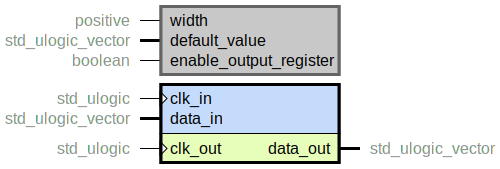
Free-running two-phase handshaking CDC for resynchronizing a vector of correlated data from one clock domain to another. Very similar to resync_twophase.vhd but uses LUTRAM instead of registers, making it extremely resource efficient.
Warning
This entity is in active development. Using it is NOT recommended at this point.
Note
This entity has a scoped constraint file resync_twophase_lutram.tcl that must be used for proper operation. See here for instructions.
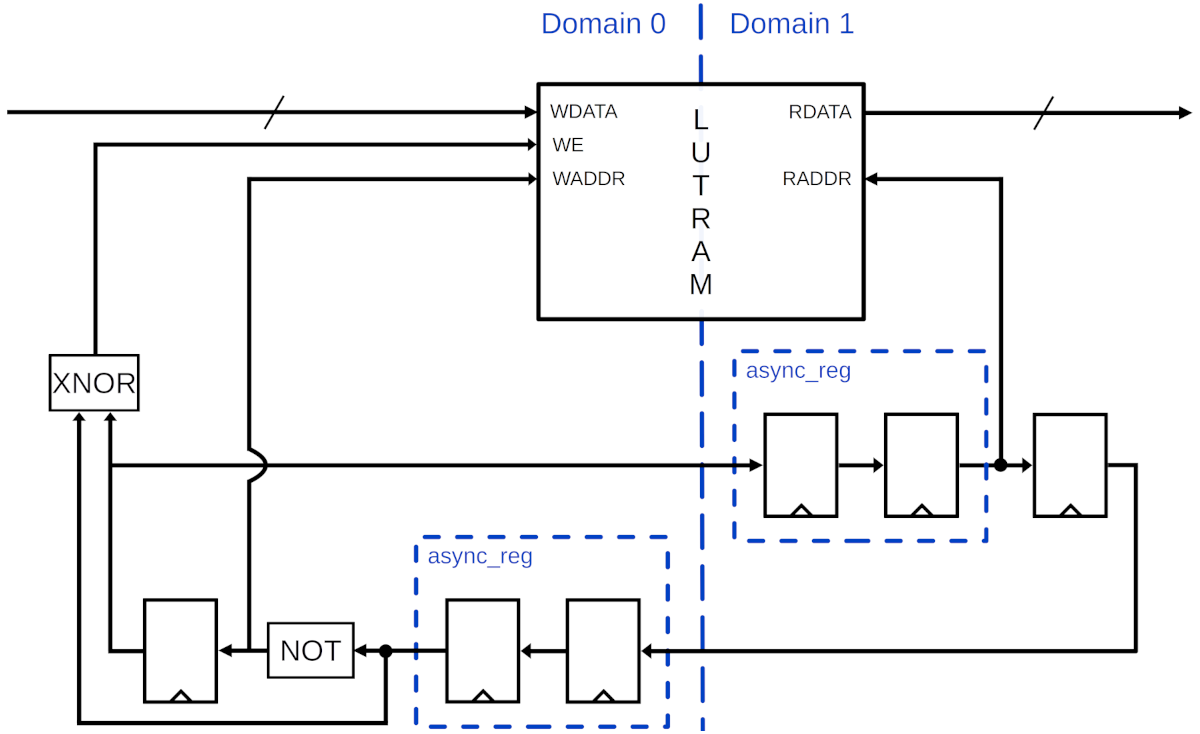
Resource utilization
This entity has netlist builds set up with automatic size checkers in module_resync.py. The following table lists the resource utilization for the entity, depending on generic configuration.
Generics |
Total LUTs |
LUTRAMs |
FFs |
Maximum logic level |
|---|---|---|---|---|
width = 8 |
10 |
8 |
6 |
2 |
width = 16 |
14 |
12 |
6 |
2 |
width = 24 |
18 |
16 |
6 |
2 |
width = 32 |
26 |
24 |
6 |
2 |
width = 64 |
46 |
44 |
6 |
2 |